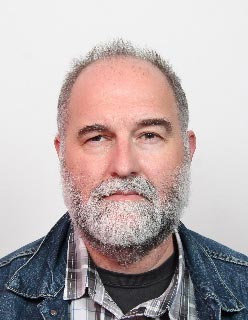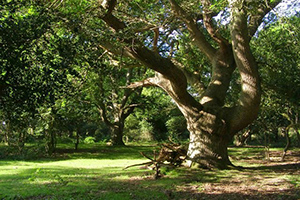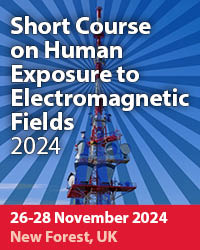Description
The course aims to cover several aspects of human interaction with non-ionizing electromagnetic fields (EMF) including not only the undesired exposure from artificial sources but also the biomedical applications of electromagnetic fields. The course deals with basic aspects of electromagnetic fields in the environment, coupling mechanisms between humans and electromagnetic fields, established biological effects of electromagnetic fields from static to high-frequency range, international safety guidelines related to limiting human exposure to those fields, including relevant exposure limits and safety guidelines, electromagnetic-thermal dosimetry models and the related analytical/numerical solution methods.
Illustrative examples include analysis of power lines, transformer substations, PLC systems, RFID antennas, wireless power transfer (WPT) systems and radio base stations pertaining to 2G/3G/4G and 5G mobile communication systems.
This is followed by some examples of biomedical applications of electromagnetic fields, including transcranial magnetic stimulation (TMS), transcranial electrical stimulation (TES), and also some electrotherapy and magnetotherapy techniques. In addition, some illustrative computational examples pertaining to thermal modelling of certain ophthalmological procedures will be given.
Finally, the last part of the tutorial deals with the stochastic modelling of electromagnetic fields. As input parameters of models used in bioelectromagnetism and electromagnetic dosimetry suffer from inherent uncertainty they are treated as random variables.
Target audience
Who should attend:
- Multidisciplinary Researchers
- Engineers, Physicists and mathematicians
- Representatives from Communication and Power engineering Companies
- Biologists and Biomedical Scientists
- Undergraduate, PhD and Postdoc Students
- Professionals interested in various aspects of Bioelectromagnetics
- Developers of technical projects
- Specialists for new technologies
- Government, public and industrial representatives
- Technical project developers
- Technical executives and managers of industrial enterprises
Course Programme
The course will run daily from 9 am to 5 pm.
- Day 1 – Morning
- On Exposure of Humans to Electromagnetic Fields – General Considerations
Introduction, Coupling Mechanisms and Biological Effects, Safety Guidelines and Exposure Limits - Introduction to Computational Electromagnetics (CEM)
Fundamentals of electromagnetic theory, Antenna analysis, Numerical methods, Outline of Finite Element Method (FEM) and Boundary Element Method (BEM)
- On Exposure of Humans to Electromagnetic Fields – General Considerations
- Day 1 – Afternoon
- Incident Electromagnetic Field Dosimetry
Assessment of External Electric and Magnetic Fields at Low Frequencies (LF) and High Frequencies (HF), Calculation and measurement procedures, Analysis of power lines, substation transformers, power line communication systems (PLC), RFID antennas, base station antenna systems) - Internal dosimetry – Simplified models of the Human Body
Canonical body models (Parallelepiped Model of the Human Body, Cylindrical Antenna Models of the Body, Transmission line models) Frequency and Time Domain Analyis)
- Incident Electromagnetic Field Dosimetry
- Day 2 – Morning
- Internal dosimetry – Realistic Models for Static and Low Frequency (LF) Dosimetry
Human Head Exposed to Electrostatic Field, Whole Body Exposed to LF Fields (Multi-Domain Model of the Body, Realistic Model of the Human Body, Pregnant Woman/Fetus Exposed to ELF Electric Field)
- Internal dosimetry – Realistic Models for Static and Low Frequency (LF) Dosimetry
- Day 2 – Afternoon
- Internal electromagnetic-thermal dosimetry – Realistic Models for Human Exposure to High Frequency (HF) Radiation
The Human Eye Exposure, The Brain Exposure, The Human Head Exposure, The Whole Body Exposure, Thermal Dosimetry Procedures
- Internal electromagnetic-thermal dosimetry – Realistic Models for Human Exposure to High Frequency (HF) Radiation
- Day 3 – Morning
- Biomedical Applications of Electromagnetic Fields
Transcranial Magnetic Stimulation (TMS), Transcranial Electric Stimulation (TES), Nerve Fiber Excitation, Laser Radiation - Stochastic Bioelectromagnetics
Introduction, Stochastic Collocation Method (SCM) for Uncertainty Quantification (UQ) and Uncertainty Propagation (UP), Sensitivity Analysis Approaches, Simplified canonical body models, Realistic Body Models, Biomedical Applications
- Biomedical Applications of Electromagnetic Fields
- Day 3 – Afternoon
- Hot topics – Human Exposure to 5G communication systems: Incident and Internal Dosimetry Procedures
Calculation and Measurement Methods for Fields Radiated by 5G Systems, Incident Power Density and Absorbed Power Density, Surface temperature Increase
- Hot topics – Human Exposure to 5G communication systems: Incident and Internal Dosimetry Procedures
Presenter
 Dragan Poljak received his PhD in Electrical Engineering in 1996 from the University of Split, Croatia. He is the Full Professor at Department of Electronics and Computing, University of Split. His research interests are oriented to computational electromagnetics (electromagn. compatibility, bioelectromagnetics and plasma physics). To date, Prof. Poljak has published more than 160 journ. and 250 conf. papers, and authored some books, e.g. two by Wiley, New Jersey and one by Elsevier, St Louis. He is a Senior Member of IEEE, a member of the Editorial Board of Eng. Anal. with Boundary Elements, Math. Problems in Eng. And IET Sci. Measur. & Techn. He was awarded by several prizes for his research achievements, such as National Prize for Science (2004), Croatian sect. of IEEE annual Award (2016), Technical Achievement Award of the IEEE EMC Society (2019) and George Green Medal from the University of Mississippi (2021). From May 2013 to June 2021 Prof. Poljak was a member of the board of the Croatian Science Foundation. He was involved in ITER physics EUROfusion collaboration and he is currently involved in DONES EUROfusion collaboration and in the Croatian center for excellence in research for tech. sciences. He is active in a few Working Groups of IEEE/Internat. Committee on Electromagnetic Safety (ICES) Tech. Comm. 95 SC6 EMF Dosimetry Modeling.
Dragan Poljak received his PhD in Electrical Engineering in 1996 from the University of Split, Croatia. He is the Full Professor at Department of Electronics and Computing, University of Split. His research interests are oriented to computational electromagnetics (electromagn. compatibility, bioelectromagnetics and plasma physics). To date, Prof. Poljak has published more than 160 journ. and 250 conf. papers, and authored some books, e.g. two by Wiley, New Jersey and one by Elsevier, St Louis. He is a Senior Member of IEEE, a member of the Editorial Board of Eng. Anal. with Boundary Elements, Math. Problems in Eng. And IET Sci. Measur. & Techn. He was awarded by several prizes for his research achievements, such as National Prize for Science (2004), Croatian sect. of IEEE annual Award (2016), Technical Achievement Award of the IEEE EMC Society (2019) and George Green Medal from the University of Mississippi (2021). From May 2013 to June 2021 Prof. Poljak was a member of the board of the Croatian Science Foundation. He was involved in ITER physics EUROfusion collaboration and he is currently involved in DONES EUROfusion collaboration and in the Croatian center for excellence in research for tech. sciences. He is active in a few Working Groups of IEEE/Internat. Committee on Electromagnetic Safety (ICES) Tech. Comm. 95 SC6 EMF Dosimetry Modeling.
Location
 The New Forest is one of the UK's most popular tourist destinations and offers many attractions all year round, including picturesque forest villages as well as beautiful scenery. It is located in Southern England, spreading over 150 square miles of Hampshire. The New Forest was established as a royal hunting ground by King William I, and by the 14th century, the land was being used to produce timber for the shipbuilding industry on the south coast. Today, after nearly 1000 years, the forest is still Crown property and is administered by the Forestry Commission. Since the reign of King William I commoners have been given the right to graze their livestock, normally ponies, cattle and pigs, on Forest land where they wander freely. In the New Forest, the well-being of the animals and the special needs of the countryside are a priority. The Forest is unarguably recognised as one of the most unique and important wilderness areas in Western Europe and, because of this, it is now a National Park.
The New Forest is one of the UK's most popular tourist destinations and offers many attractions all year round, including picturesque forest villages as well as beautiful scenery. It is located in Southern England, spreading over 150 square miles of Hampshire. The New Forest was established as a royal hunting ground by King William I, and by the 14th century, the land was being used to produce timber for the shipbuilding industry on the south coast. Today, after nearly 1000 years, the forest is still Crown property and is administered by the Forestry Commission. Since the reign of King William I commoners have been given the right to graze their livestock, normally ponies, cattle and pigs, on Forest land where they wander freely. In the New Forest, the well-being of the animals and the special needs of the countryside are a priority. The Forest is unarguably recognised as one of the most unique and important wilderness areas in Western Europe and, because of this, it is now a National Park.
Venue and Accommodation
The course will take place at the Wessex Institute at Ashurst Lodge located in the New Forest, an outstanding National Park that borders the South Coast. Ashurst Lodge is an ideal venue for conferences, courses and seminars. The participants can benefit from an excellent standard of accommodation in various hotels or bed and breakfasts in the area. The surroundings are equally appealing to those who enjoy walking, horse riding, cycling, sailing and fine landscapes.
For more information on how to find Ashurst Lodge and to arrange accommodation during the courses please use the information provided on the Contact Us page.



 Wessex Institute
Wessex Institute